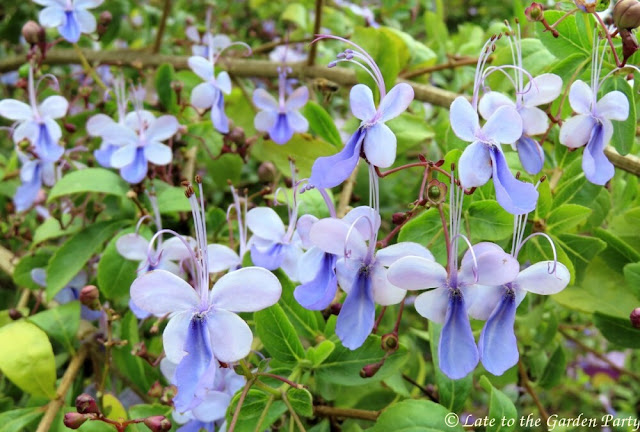Last Friday, I posted part one of my June tour of South Coast Botanic Garden. Today's post covers where that one left off, starting with the Palm Circle near the entrance to the garden.
 |
| The Palm Circle was planted up with a lot of tropicals, including banana trees for the summer season |
The Pollination Garden lies just beyond the Palm Circle. Last year, it was initially planted with annuals to cover the bare ground. In November, when the annuals were spent, the garden staff planted natives that are known to attract pollinators. Most of the natives will take time to become established but, luckily for visitors, a wide range of annuals showed up to fill in the empty spots this summer.
I popped into the small tropical greenhouse, which was more disappointing than usual.
I spent more time than usual in the Rose Garden but then roses are especially deserving of attention when they peak in early summer. They were plentiful, although they could have benefited from deadheading. I sought out the most perfect blooms I could find.
 |
| Clockwise from the upper left, the roses include: 'Gemini', 'Judy Garland', 'Julia Child', 'Love & Peace', 'Sexy Rexy', 'Sparkle & Shine', and 'Love Song' |
 |
| Last year, the garden added tropical plants, including Cannas, to one area of the Rose Garden that was prone to damp soil. They were looking their best at the time of my visit. |
 |
| In a drier area, staff and volunteers had added masses of Pelargoniums and lavender |
 |
| They added masses of true Geraniums too. I wish these were happy in my garden but I suspect SCBG is more generous with their water rations than I am. |
The former Mediterranean Garden that was situated near the Rose Garden no longer exists as a defined garden area. Part of the area it formerly encompassed sits behind construction fencing but the area directly opposite the Rose Garden, previously covered by an expansive mass of Salvia leucantha (aka Mexican bush sage) is now planted with a wide range of drought-tolerant plants.
 |
| This photo was taken last year (June 14, 2023) when the area was still covered in Salvia leucantha |
As I headed to the exit, I passed through an area I used to refer to as the "promenade" because it led from the Palm Circle to the formal entrance of the Rose Garden, an area often used for wedding events.
I'd hoped to have a chance to walk through the upper meadow, which was closed during each of my earlier visits to the garden this year. I understand that the garden has installed a row of Grevilleas there but I've yet to have the opportunity to see them. I found the upper meadow closed yet again, although I entirely support the reason for this particular closure.
 |
| Children of various ages were using their summer break to engage in a new learning experience |
Now that the marine layer is lifting very early, if it's present at all, I may schedule a visit to the butterfly exhibit in early July. Fingers crossed that I find a suitable slot when the temperature is neither too cool (for the butterflies) or too hot (for me). In the meantime, may you all find a sweet spot in the weather this weekend.
All material © 2012-2024 by Kris Peterson for Late to the Garden Party














































